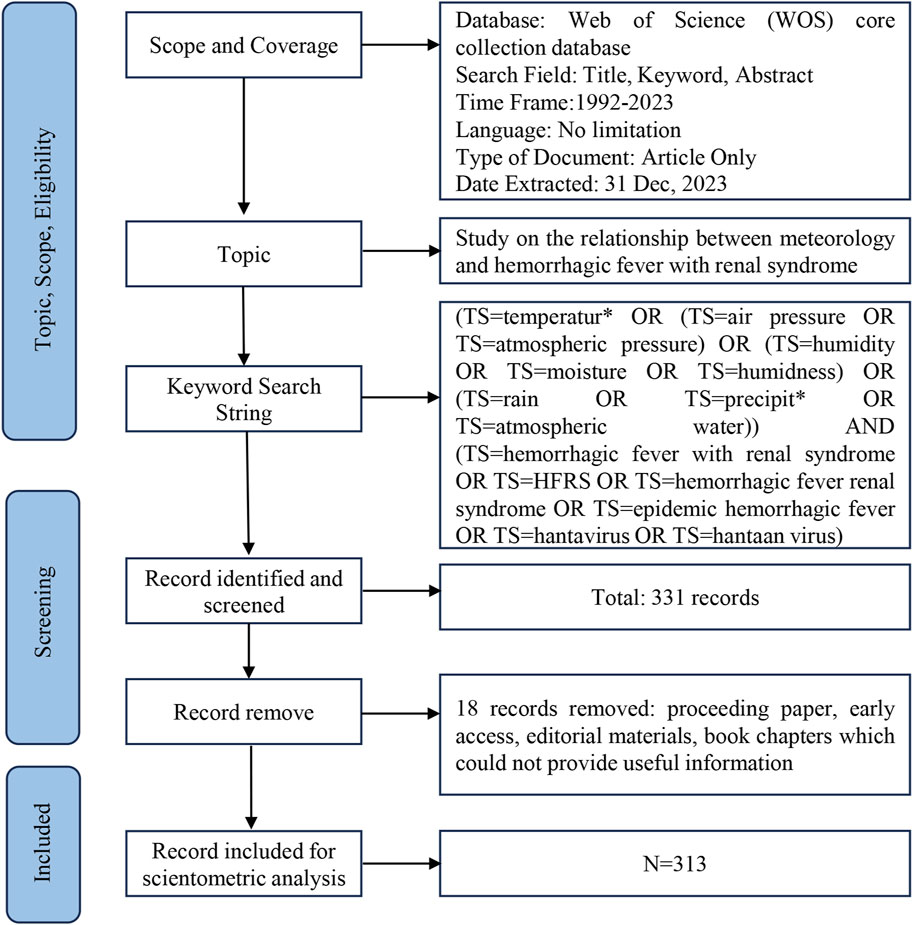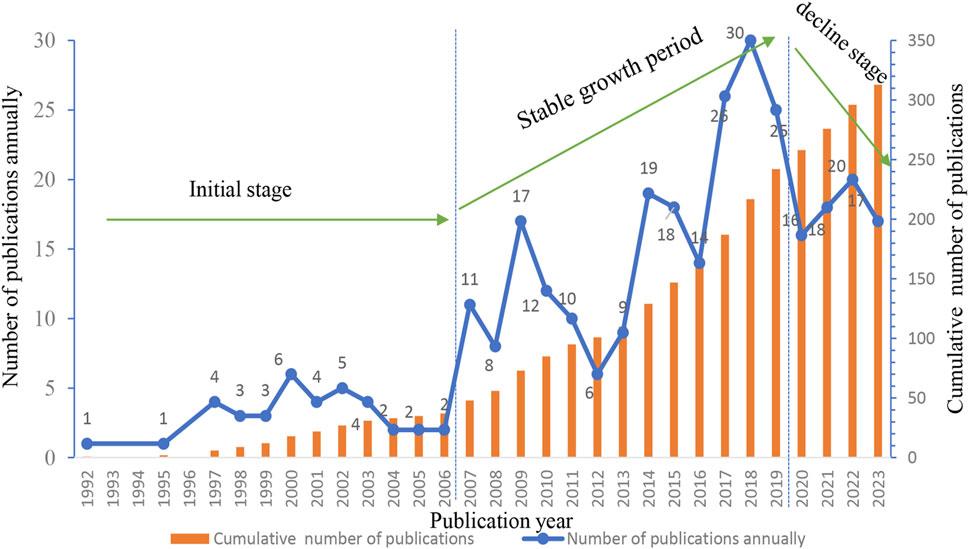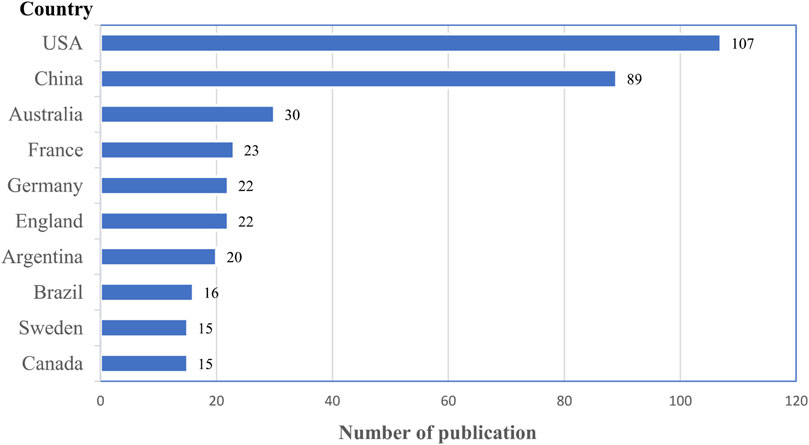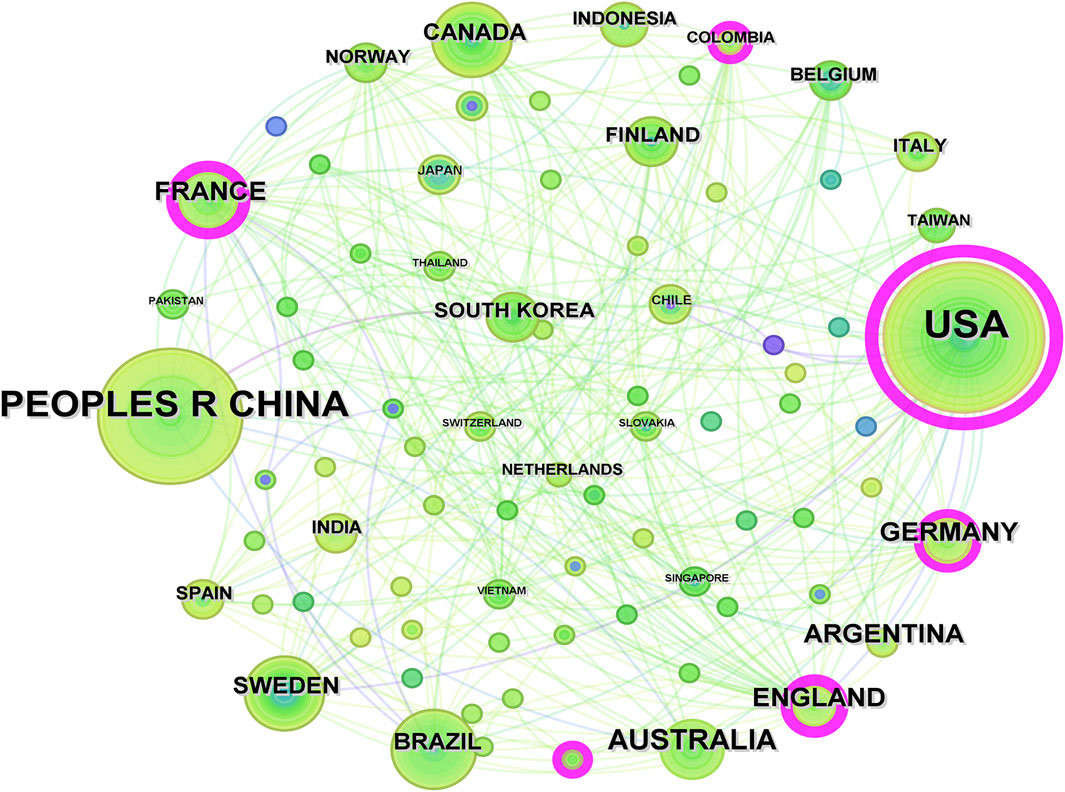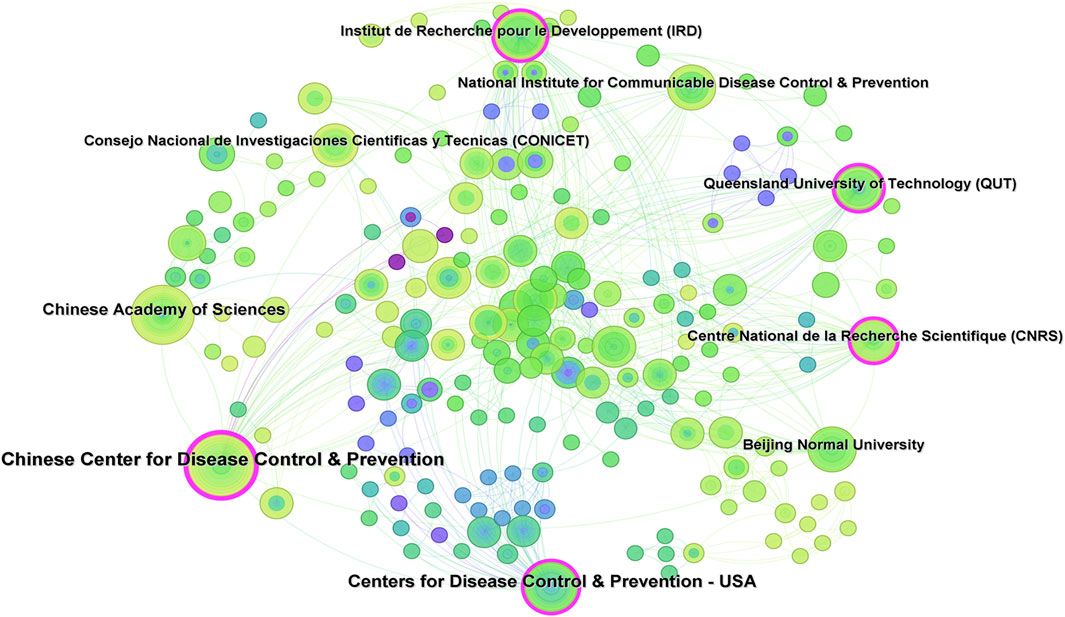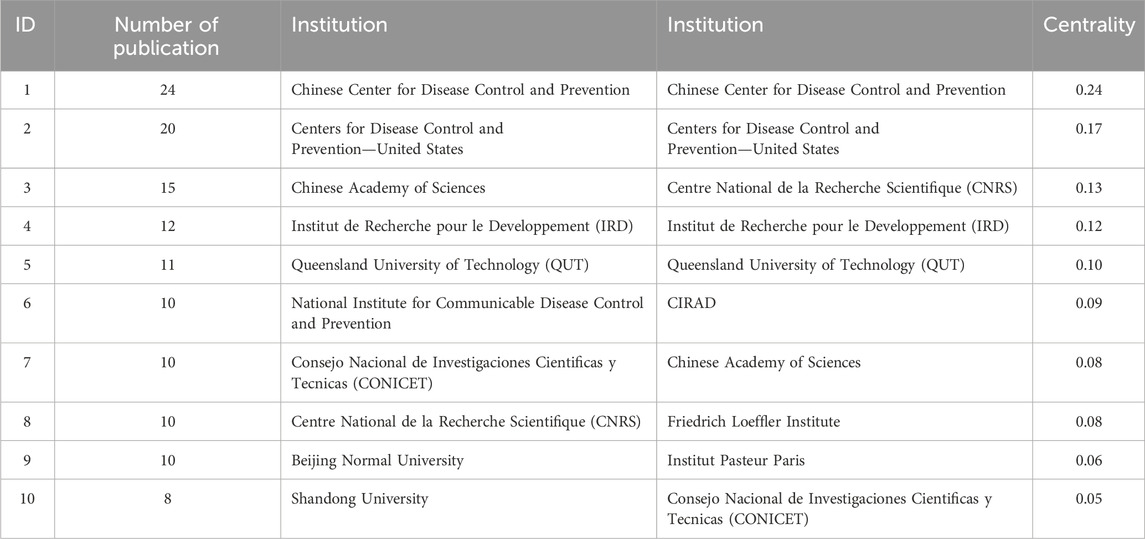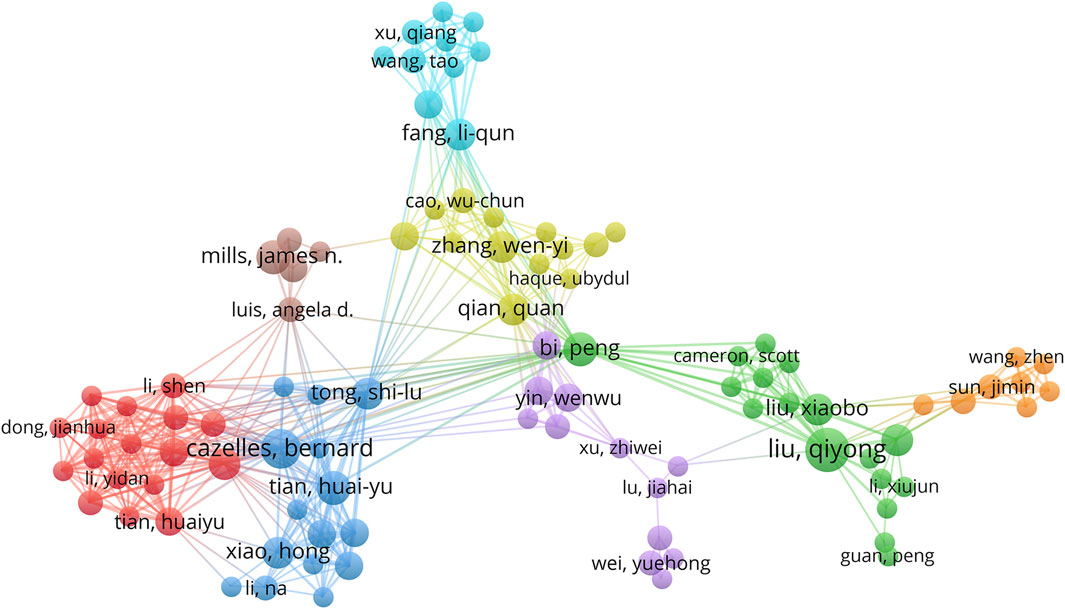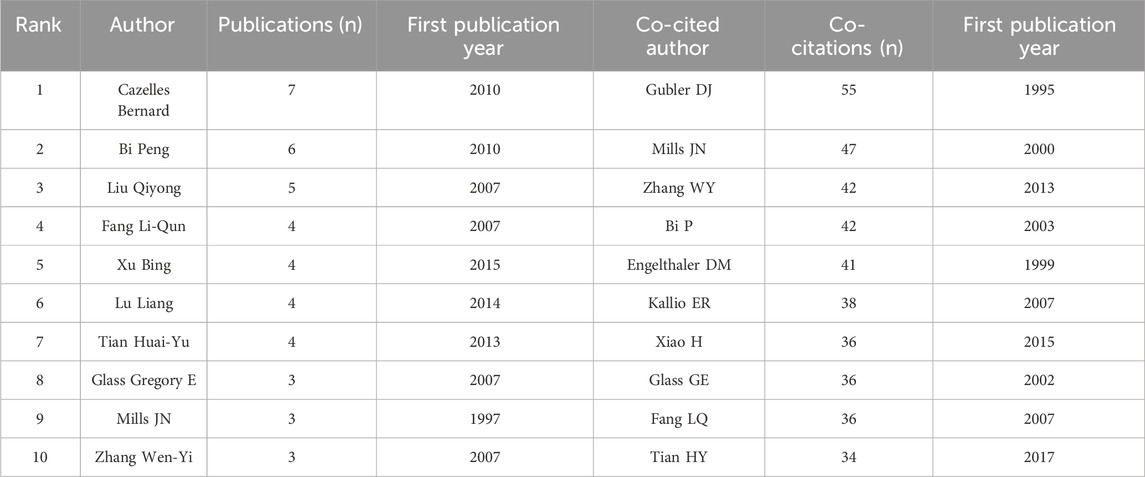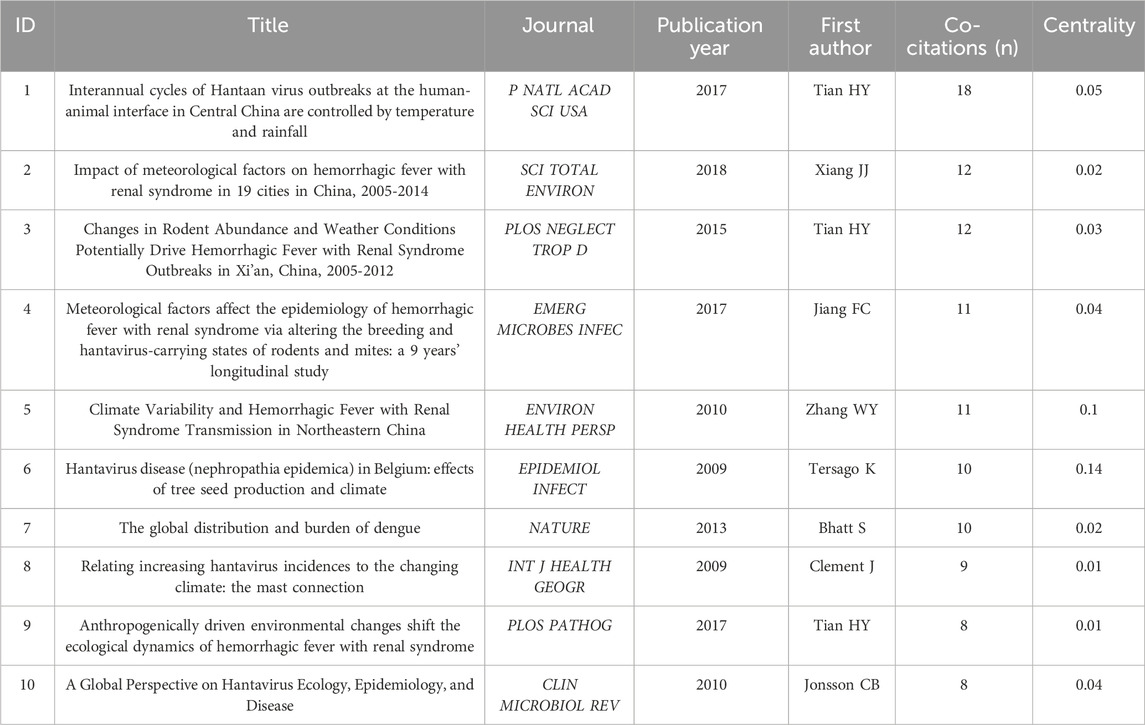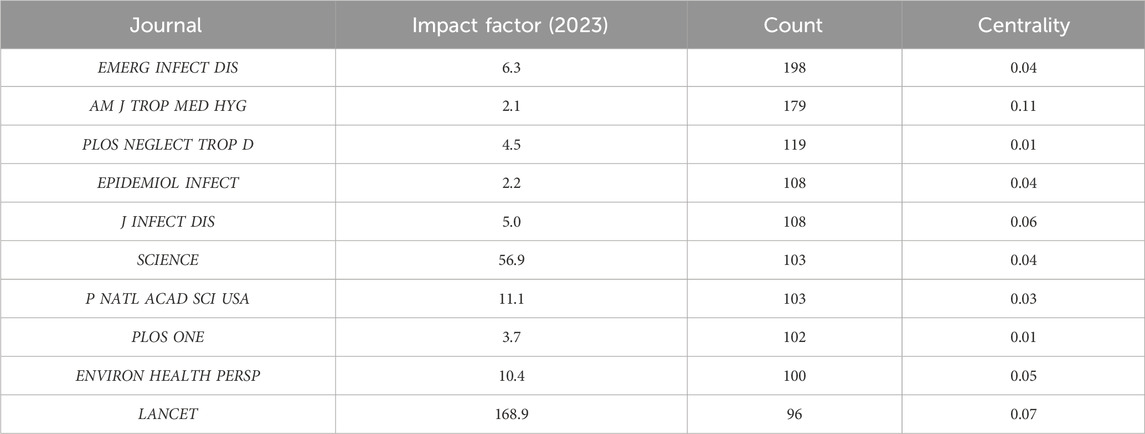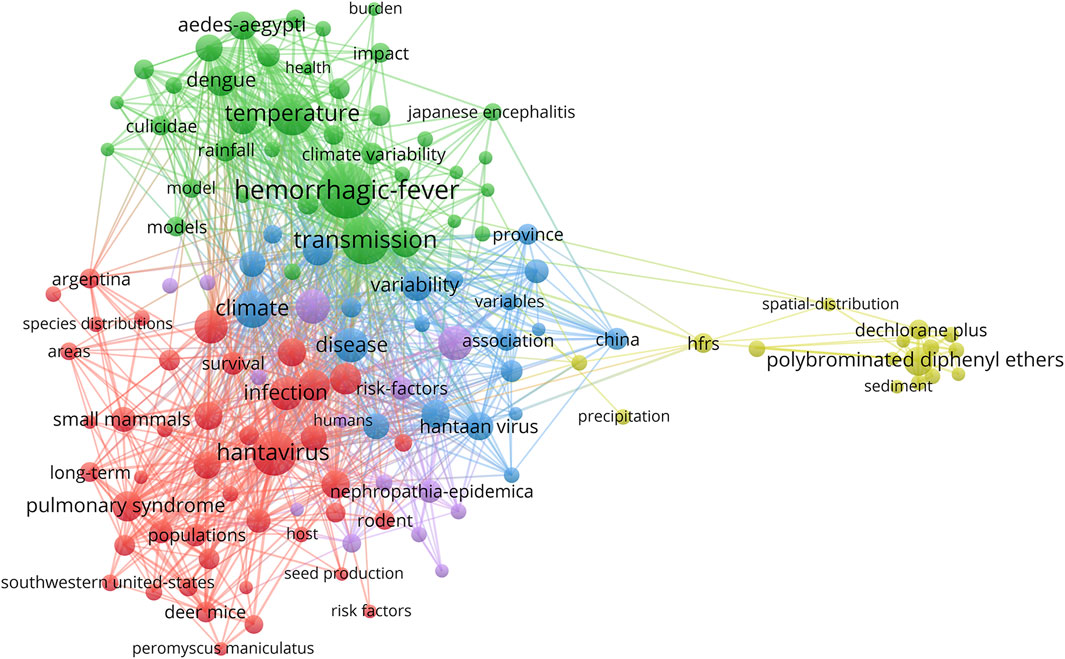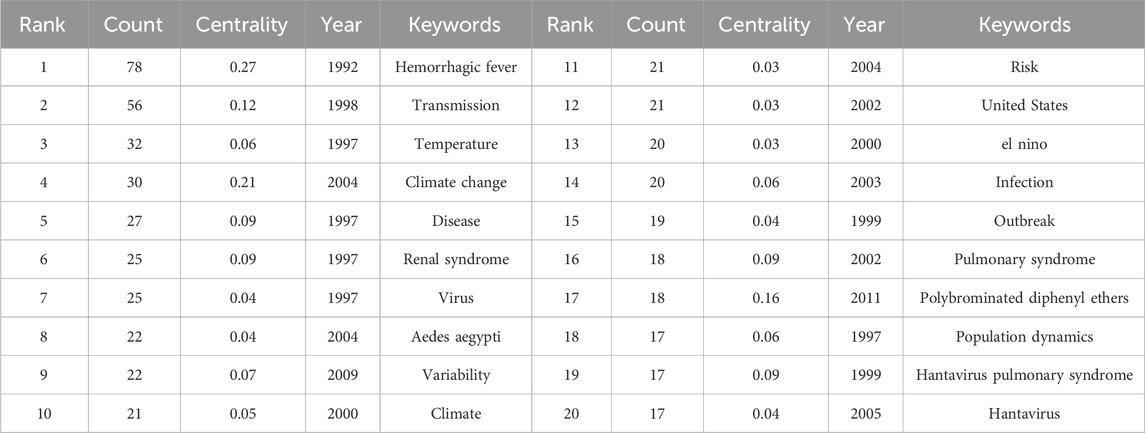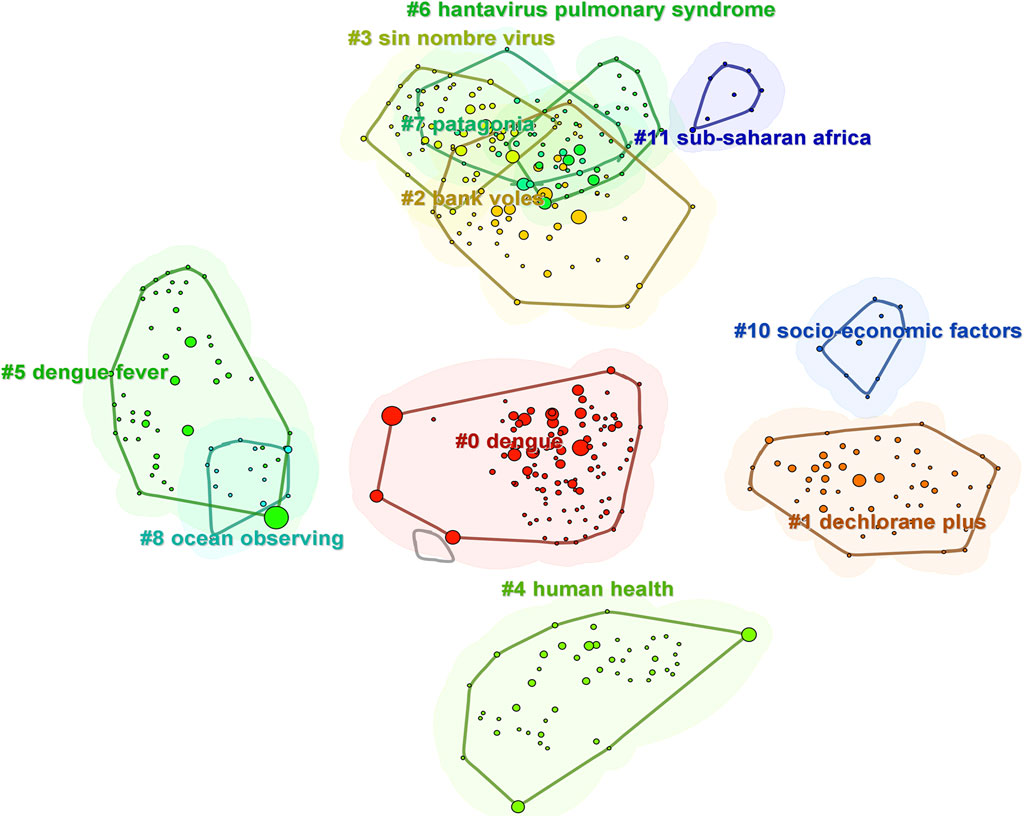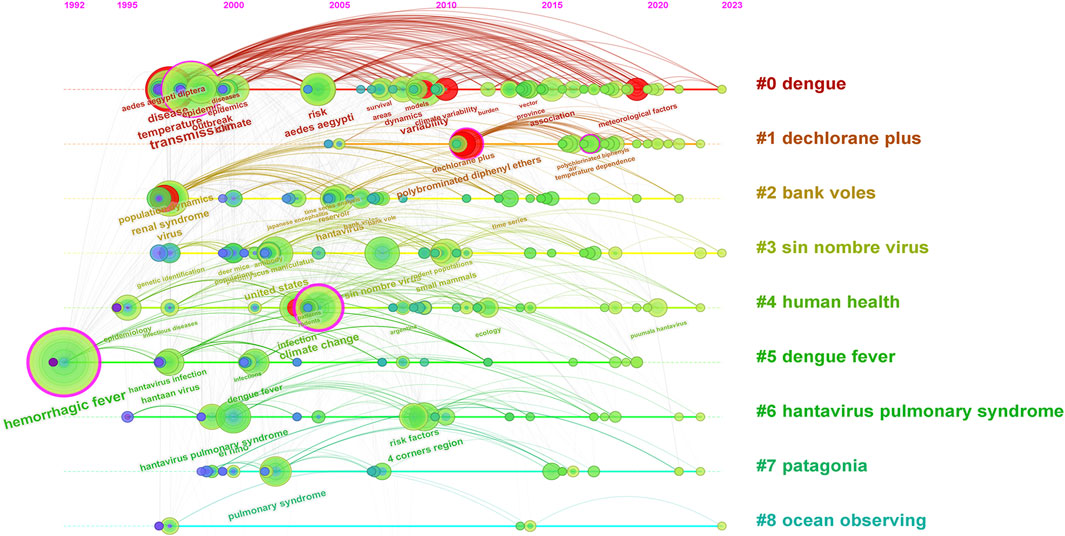- Jiangxi Provincial Key Laboratory of Major Epidemics Prevention and Control, Young Scientific Research and Innovation Team, Jiangxi Provincial Center for Disease Control and Prevention, Nanchang, Jiangxi, China
Objective: We here displayed the global research trends of meteorology and hemorrhagic fever with renal syndrome (HFRS) as a visual knowledge map by using bibliometrics and revealed the research directions, hotspots, trends, and frontiers in this field.
Methods: Using Web of Science core collection as the data source and with CiteSpace and VOSviewer software, we collected and analyzed the annual number of papers, cooperative relationships (countries, institutions, authors, etc.), citations (literature citation, literature co-citation, literature publication, etc.), keywords (emergence, clustering, etc.) of meteorology, and HFRS-related research data for the past 30 years, and drew a visual map.
Results: In total, this study included 313 papers investigating the relationship between meteorology and HFRS. The first paper was published in 1992. Globally, United States had the largest number of publications in this field, and the Chinese Center for Disease Control and Prevention was the most influential institution conducting related research (20 articles published, and the mediation centrality was 0.24). Several small author cooperation clusters were formed; however, the number of papers published by the same scholar and the co-citation frequency were low. Cazelles Bernard (7 articles) published the highest number of articles in this field, and Gubler DJ was the author with the most co-citations (55 times). The most frequently cited journal was Emerging Infectious Diseases. In this field, the top three high-frequency keywords were “hemorrhagic fever,” “transmission,” and “temperature.” According to keyword cluster analysis, the top three themes were dengue, dechlorane plus, and bank voles. The timeline spectrum exhibited that dengue clustering had a good temporal continuity. The trend analysis of emergent words revealed that the research on “temperature,” “meteorological factors” and “Puumala hantavirus” has gradually appeared in recent years.
Conclusion: This study represents the first comprehensive exploration of global trends, hotspots, frontiers, and developments in the relationship between meteorology and HFRS, utilizing CiteSpace and VOSviewer software. The findings of this study are crucial for elucidating the influence of climate change on disease transmission patterns and offering novel insights for forthcoming epidemiological research and public health interventions.
1 Introduction
Hemorrhagic fever with renal syndrome (HFRS), also known as epidemiological hemorrhagic fever, is a zoonotic acute viral infectious disease (Cosgriff, 1989). HFRS is caused by Hantavirus (HV), with striped field mice (Apodemus agrarius) and stout rodents (Microtus striatus) being the main virus hosts. HFRS is globally prevalent and is endemic in Asia and Europe, including Russia, China, Japan, the Korean Peninsula, Northern Europe, and the Balkans.
The HFRS prevalence is closely related to meteorological factors such as temperature, humidity, and rainfall (Bi et al., 2021; Douglas et al., 2021; Zhang et al., 2022; Lv et al., 2023). The warm season is favorable for rodent breeding and they are more active, which increases their chances of contact with humans, thus heightening the virus transmission risk (Donalisio and Peterson, 2011). At a high temperature, the virus survival time may be shortened; however, HV more likely spreads as aerosols (Vapalahti et al., 2010). At suitable temperatures, virus reproduction may be accelerated, thereby increasing the likelihood of virus variation and evolution, which indicates that temperature may affect virus variation and evolution (Fay et al., 2021).
Rainfall is also highly correlated with the HFRS prevalence. A high rainfall increases vegetation growth and rodent density, thus elevating the chances of human contact with infected rodents. Floods and droughts alter the abundance and distribution of rodents through migration (Bodmer et al., 2018). Flooding may deteriorate rodent habitats, leading to the migration of rodents to human habitation and thus increasing the virus transmission risk (Sharnuud and Ameca, 2023). During droughts, a decrease is noted in the rodent predation risk, food availability, and rodent transmission risk rates (Yue and Lee, 2020).
Bibliometric analysis is a progressive method used to efficiently investigate the current status and trends within a specific subject or domain through statistical methods and visualization (Wang et al., 2021). This technique involves identifying key elements and extracting valuable insights from extensive data sets. Bibliometric software plays a vital role in scientometric analysis, where tools like CiteSpace and VOSviewer are widely favored for visualizing and analyzing trends and patterns in scientific literature. While the impact of meteorology on human health has emerged as a focal point of global scholarly research, comprehensive visual analysis is still lacking when it comes to studying the relationship between meteorology and the prevalence of HFRS from a global perspective (Khraishah et al., 2022; Romanello et al., 2022; Silenzi et al., 2023; Sri et al., 2023). This bibliometric analysis introduces a unique perspective by focusing on the intersection of meteorology and hemorrhagic fever with renal syndrome (HFRS), a niche that has been underexplored in the existing literature. Therefore, this study used CiteSpace and VOSviewer software to deeply explore the relevant literature from the perspective of visual analysis, and investigate the research hotspots, trends, and frontiers of the aforementioned relationship so as to provide a reference for future research and development.
2 Materials and methods
2.1 Inclusion and exclusion criteria
The Web of Science (WOS) core collection was used for literature search. Science Citation Index Expanded, Social Sciences Citation Index, and Emerging Sources Citation Index were searched. Studies meeting the following criteria were considered eligible: 1) studies on meteorology and HFRS; 2) studies providing basic information such as the name of the author, country, institution, keywords and references for research and analysis; and 3) studies published between the database establishment date and 31 December 2023. No restrictions were applied to the language of the articles. We excluded meeting abstracts, letters, editorial materials, corrections, proceedings, and duplicate literature from the study.
2.2 Literature search
Following the inclusion and exclusion criteria outlined above, we conducted a systematic literature search with the aim of comprehensively collecting research articles relevant to the relationship between meteorology and HFRS. Articles were searched from 01 January 1992, to 31 December 2023, by using the following search formula: (TS = temperatur* OR (TS = air pressure OR TS = atmospheric pressure) OR (TS = humidity OR TS = moisture OR TS = humidness) OR (TS = rain OR TS = precipit* OR TS = atmospheric water) AND (TS = hemorrhagic fever with renal syndrome OR TS = HFRS OR TS = hemorrhagic fever renal syndrome OR TS = epidemic hemorrhagic fever OR TS = hantavirus OR TS = hantaan virus). In total, 331 relevant articles were retrieved. Then, 18 publications, including early access, meetings, letters, editorial materials, and book chapters, were excluded as they could not provide useful information (countries of authors, institutions of authors, keywords, and references) for bibliometric analysis. All 313 retrieved articles were imported into CiteSpace software for data reprocessing, and no duplicate studies were found. Finally, 313 articles were included in the study. Figure 1 presents the literature retrieval and screening process.
2.3 Ethical approval
The need for ethical approval for this review was waived because all the data used in this study were extracted from previously published articles.
2.4 Statistical analysis
CiteSpace 6.2, VOSviewer 1.6 and Excel 2016 software were used to identify journals, institutions, countries, co-occurrence of keywords, co-cited articles, and trends. Meanwhile, the knowledge map of the analyzed content was also visualized.
Keyword/topic co-occurrence analysis is utilized to observe the research focal points within a specific field. Co-citation analysis or keyword bursting examination is employed to identify the research frontiers in the field. Clustering analysis of keywords/topics, combined with timeline graph analysis, is utilized to analyze the evolutionary trajectory of research. By exploring the network of author/institutional collaborations, notable figures and core groups within a research domain can be identified. Additionally, studying interdisciplinary integration between disciplines is facilitated through co-occurrence network analysis of journals.
3 Results
3.1 Analysis of annually published papers
Finally, 313 valid articles were included in this study. The first paper in this field was published in 1992 (Hung et al., 1992). From 1992 to 2006, studies investigating the correlation between meteorology and HFRS were in the initial exploration stage, and the number of related papers was very few. From 2007 to 2019, this field experienced a rise in development, and the number of publications was increasing. Since 2020, the number of publications has been declining (Figure 2). Despite the modest number of papers, the consistency of the publication trends and the clear patterns observed in the data suggest that our results are robust and reflective of the field’s status.
3.2 Analysis of cooperative map
3.2.1 Analysis of national published papers and co-occurrence map
In total, 79 countries have conducted studies to determine the relationship between meteorology and HFRS. Among these countries, United States was the country with the largest number of publications, accounting for one-third of the total number of publications (107). United States was followed by China (89 articles) and Australia (30 articles). These three countries contributed to 72% of all publications. Figure 3 presents the top 10 countries in terms of the publication number. In this research area, high mediation centrality was chiefly concentrated in the United States (0.72), England (0.27), France (0.24), Saudi Arabia (0.14), Germany (0.13), Colombia (0.11), and Australia (0.10). The mediation centrality of the remaining countries was <0.10 (Figure 4).
3.2.2 Analysis of publications and cooperation map of institutions
Figure 5 presents the cooperative network of research institutions in this field, with the nodes representing institutions. Larger nodes indicate a larger publication volume of the institution, and the thicker connection between the nodes indicates a greater intensity of cooperation between the two nodes. Globally, 341 research institutions have conducted studies investigating the relationship between meteorological factors and HFRS. The top three research institutions with the largest number of published articles were the Chinese Center for Disease Control and Prevention (24 articles), the Centers for Disease Control and Prevention-USA (20 articles), and the Chinese Academy of Sciences (15 articles). The cooperative intermediary centrality of only five institutions exceeded 0.1, namely, the Chinese Center for Disease Control and Prevention (0.24), Centers for Disease Control and Prevention-USA (0.17), Centre National de la Recherche Scientifique (0.13), Institut de Recherche pour le Developpement (0.12), and Queensland University of Technology (0.10) (Table 1).
3.2.3 Author cooperation map analysis and co-cited authors analysis
To explore influential authors in the investigated research field, we drew the distribution map of the cooperative relationship network of 192 authors who appeared ≥2 times (Figure 6). Each node represents an author, and different colors indicate different cooperative clusters. The results unveiled that several small collaborative clusters have emerged in the research on the meteorology–HFRS relationship.
Table 2 lists the top 10 authors with the highest number of publications and the top 10 authors with a co-citation frequency. The top three authors with the highest number of publications were Cazelles Bernard (7 articles), Bi Peng (6 articles), and Liu Qiyong (5 articles). The top three co-cited authors were Gubler DJ (55 articles), Mills JN (47 articles), and Zhang WY (42 articles). The research results of these scholars are extensively recognized in this field.
3.3 Map analysis of co-cited literature
Co-citation relationships pertain to the phenomenon where two or more papers are cited simultaneously in other single paper. The frequency of co-citations serves as a dependable indicator of the paper’s influence and authority within a particular knowledge domain. In our study, the 313 publications cited 11,649 articles. Table 3 presents the top 10 most frequently co-cited papers (Clement et al., 2009; Tersago et al., 2009; Jonsson et al., 2010; Zhang et al., 2010; Bhatt et al., 2013; Tian et al., 2015; Tian et al., 2017a; Tian et al., 2017b; Jiang et al., 2017; Xiang et al., 2018). The first highly co-cited paper was “Interannual cycles of Hantaan virus outbreaks at the human-animal interface in Central China are controlled by temperature and rainfall” in 2017 (Tian et al., 2017b). It has a total of 18 citations.
3.4 Map analysis of co-cited journals
The 11,649 cited articles were published in 558 journals. Table 4 lists the top 10 most frequently cited journals. This list indicates that these journals include more papers on meteorological and HFRS research. Of them, Emerging Infectious Diseases was the most frequently cited journal (total citation: 198).
3.5 Keyword analysis
3.5.1 Co-occurrence analysis
Keywords summarize and introduce the main content and key information presented in the literature. Through the summary and analysis of the used keywords, the research hotspots and directions of a certain field can be determined and investigated. This study generated 1,691 keywords, and 132 keywords with a co-occurrence frequency of ≥5 times were analyzed through VOSviewer (Figure 7). Table 5 presents the top 20 high-frequency keywords in frequency ranking. The top 5 high-frequency keywords were hemorrhagic fever, transmission, temperature, climate change, and disease.
3.5.2 Cluster analysis
During the cluster analysis (Figure 8), keywords primarily formed 12 clusters. Among these clusters, the top five clusters were dengue, dechlorane plus, bank voles, Sin Nombre virus, and human health.
3.5.3 Timeline and burst word analysis
A timeline map was drawn for keyword clustering (Figure 9) to analyze the changes in keywords over time. “Hemorrhagic fever” was the first keyword with a high mediation centrality that appeared for the first time in the dengue fever cluster. Regarding timeline, dengue clustering exhibited a good temporal continuity, indicating high attention. Dechlorane plus clustering is a research hotspot that just emerged in the past decade and has gained considerable attention. Patagonia and ocean observing clusters exhibited a weak temporal continuity, indicating low attention.
Figure 10 presents the top 25 major emergent terms in the research on the relationship between meteorology and HFRS. In the emergence map, strength represents the emergence value. The higher the value, the higher the credibility of the emergent word in a certain period. The present study noted that “polybrominated diphenyl ethers” (5.35) had the highest emergence value. In terms of the evolution of emergent words, the two keywords “genetic identification” and “El nino” lasted for 10 years. This indicated that the themes represented by the two keywords have been global research hotspots during that emergence period. Furthermore, the emerging keywords before 2009 were mainly “genetic identification,” “El nino,” “patterns,” and “pulmonary syndrome.” From 2010 to 2015, the emergent words slowly changed to “Peromyscus maniculatus,” “epidemics,” “population dynamics,” and “risk.” Since 2017, the emergent words have further gradually changed to “polybrominated diphenyl ethers,” “temperature,” “meteorological factors,” “Puumala hantavirus,” etc. At present, the primary keywords that are still in the emergence stage are “temperature,” “meteorological factors,” and “P. hantavirus,” and these keywords represent the current research frontier.
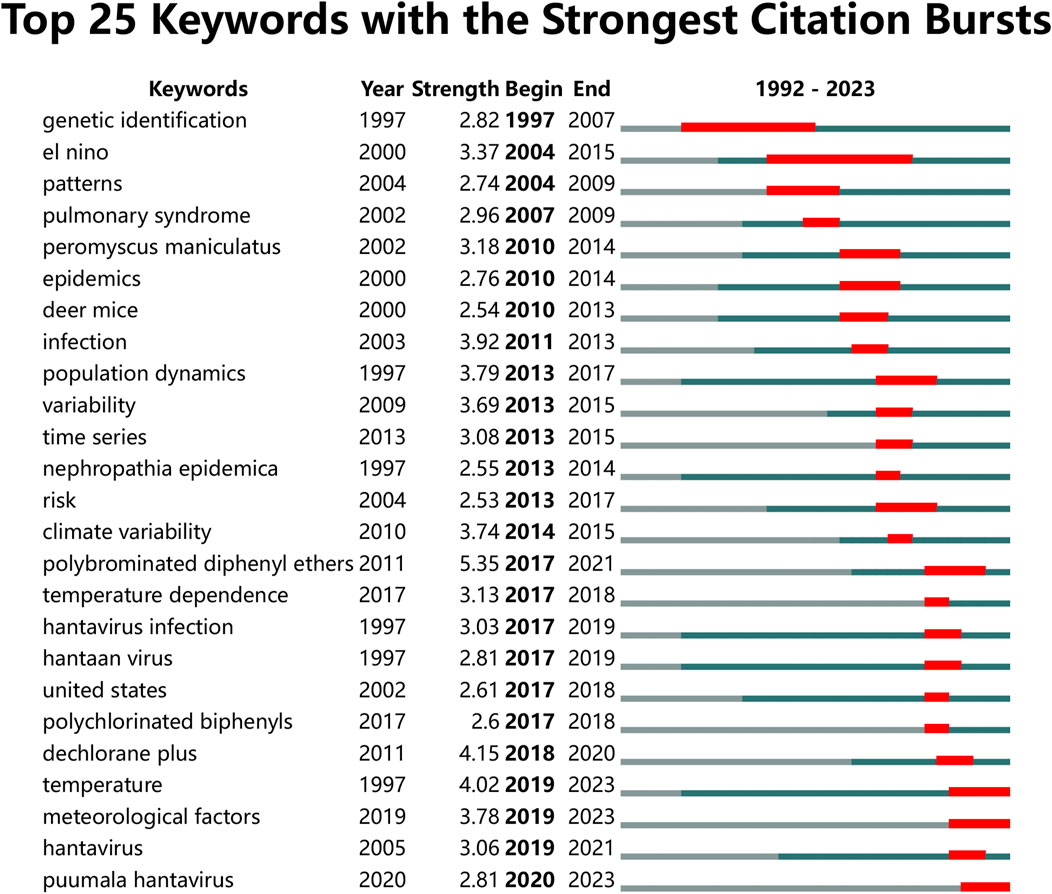
Figure 10. Map of top 25 keywords with the strongest citation bursts. (The red line represents the time period in which the keyword appears).
4 Discussion
This section will delve into the multiple layers of significance of the findings of this study. Firstly, we will analyze the correlation between meteorological factors and the transmission of HFRS. Subsequently, we will discuss the implications of the research findings for public health policies and disease prevention strategies.
This is the first study to systematically present the global research status, research hotspots, development trends, and research frontiers of meteorology and HFRS research in the past 30 years from the perspective of bibliometric analysis through CiteSpace and VOSviewer software. The present study constructed a detailed visual map to comprehensively understand meteorology and HFRS research. Through literature review, two similar studies (Kumar and Markscheffel, 2016; Wei et al., 2022) were identified; however, these studies focused on the global perspective of Hantavirus, whereas our research offers an in-depth analysis within a specific field (meteorology and HFRS).
Based on the literature search using WOS core collection, the first research result was published in 1992 (Hung et al., 1992). From 1992 to 2006, this field was in the initial exploration stage, and the research results were rarely presented as an academic article. From 2007 to 2019, the researchers were increasing, and so, the number of publications was increasing. This was related to the heightening of attention and strengthening of the impact of meteorological factors on human diseases and health. Since 2020, the number of publications has been declining, with one of the key reasons possibly attributed to the global impact of the COVID-19 pandemic, leading to challenges in conducting various experiments and research on-site (Sohrabi et al., 2021; Naseer et al., 2022). Additionally, both public and private incentives swiftly redirected resources towards COVID-19 emergency-related research areas, displacing many research fields not directly linked to the pandemic outbreak (Weiner et al., 2020; Riccaboni and Verginer, 2022). As the global COVID-19 pandemic situation has been gradually controlled and the global economy has gradually recovered, active research in this field will be initiated in the future.
In total, 79 countries worldwide have conducted studies investigating the relationship between meteorology and HFRS. One unexpected finding was the high concentration of research from the United States and China, accounting for over 60% of the publications, indicating a potential concentration of expertise and resources in these regions. The high mediation centrality in this research field was mainly concentrated in the United States (0.72), followed by England, France, and other European and American countries, which indicates that these countries have close cooperation with foreign countries. Although China (89 articles) and Australia (30 articles) ranked second and third in the number of publications, respectively, their mediation centrality was low. This indicated that the research quality or practical effect of research results from China and Australia was relatively low, and international cooperation was little. Their research results were not widely disseminated all over the world. Regarding the relationship between the number of publications and the cooperation map, the Chinese Center for Disease Control and Prevention had the highest number of publications (24 articles), with the highest mediation centrality of institution (0.24). The second institution with the highest number of publications was the Centers for Disease Control and Prevention-USA. This demonstrates the international academic influence of the aforementioned two institutions. Although the Chinese Academy of Sciences ranked third in terms of the number of publications, its mediation centrality was <0.1, confirming the need for further strengthening of the cooperation between institutions. Based on the analysis of authors and co-cited authors, only 7 papers were published by the same author in this field, and the highest number of co-cited authors was only 55 times. These data indeed indicated that relatively little cooperation and communication between authors in the research field. Moreover, scholars with extensive influence and leadership were lacking. This situation may have limited the depth and breadth of academic research, leading to a relatively gradual development of the field. To promote the progress of academic research in this field, scholars must focus more on cooperation and communication.
Keyword co-occurrence analysis and cluster analysis offered an in-depth understanding of the study topics and focus areas. In this study, the top three topics of meteorological and HFRS research were as follows: dengue field represented by “transmission,” “temperature,” “risk,” “disease” and other keywords; dechlorane plus is the second topic represented by “polybrominated diphenyl ethers,” “atmospheric deposition,” “brominated flame retardants” and other keywords. The third topic is bank voles, which are represented by keywords such as “population dynamics,” “time series analysis,” and “reservoir.” Based on the timeline spectrum of the keyword cluster analysis, we further found that dengue clustering had a good temporal continuity and gained high attention. The reason for this phenomenon may be that both dengue fever and HFRS show clinical symptoms such as hemorrhage and kidney damage, and in the prevention and control of the epidemic, mosquito control and rodent control are important means of patriotic health campaigns. Worldwide, dengue outbreaks often cause major outbreaks, and even individual cities declare public health emergencies in order to contain the development of the epidemic (Kularatne and Dalugama, 2022; Bonna et al., 2023; Parveen et al., 2023).
In order to further explore the relationship between meteorology and HFRS, study the development trend and mutation point of this subject field, and determine the potential research direction, we conducted emergent word analysis to show the words with a high frequency or use frequency over a certain period. From the annual change of emergent words, the duration of emergence of the two keywords “genetic identification” and “el nino” is as long as 10 years. This indicated that during that emergence period, the themes represented by these words “genetic identification” (Khaiboullina et al., 2005; Zhang et al., 2007) and “el nino” (Bi et al., 2005; Xiao et al., 2013) were global research hotspots. Additionally, the emergence words gradually changed from “P. maniculatus,” “epidemics,” “population dynamics,” and “risk” to “temperature,” “meteorological factors,” and “P. hantavirus” in the past decade, which illustrates the constant switching of research hotspots. However, the main keywords that are currently still in the emergence stage are “temperature,” “meteorological factors,” and “P. hantavirus.” This further suggests that these keywords represent the emerging research frontiers and future development direction in this field. While our analysis indicates potential emerging research themes, these should be considered as preliminary and subject to further validation as the field continues to evolve.
Given the dynamic nature of climate and its profound effects on vector-borne diseases, future research should delve into the long-term impacts of climate change on the epidemiology of HFRS. This could involve developing predictive models that account for shifting weather patterns and their influence on rodent populations and hantavirus transmission. Additionally, interdisciplinary collaborations could be fostered to explore innovative public health strategies aimed at mitigating the risks associated with climate-sensitive diseases like HFRS. The integration of remote sensing technologies, advanced statistical methods, and machine learning algorithms may offer new insights into the complex interplay between meteorological factors and HFRS incidence.
5 Limitation
The study limitations should not be overlooked. First of all, in order to avoid the differences in literature collection, the present study only included literature retrieved from the WOS core collection and did not search the literature included in other databases. This inevitably resulted in literature omission. While our study presents robust findings, we acknowledge the possibility of citation biases within the identified research clusters, which could influence the visibility and perceived impact of certain research themes. Secondly, bibliometrics cannot completely and accurately reflect the actual quality and influence of academic papers. This is because various factors, such as academic environment, academic norms, and academic evaluation mechanisms, may affect citations. Thirdly, bibliometric studies are assessed based on published academic papers, which may not accurately and comprehensively capture the latest research trends and new directions. Finally, while CiteSpace software excels in generating and visualizing scientific knowledge graphs, it may not be as powerful as other specialized tools for more in-depth data analysis, such as text mining and sentiment analysis. Although VOSviewer software offers basic visualization options, there may be certain limitations in terms of customization and personalization. Users may not be able to fully customize according to their own needs, resulting in visualization results that are not intuitive or do not align with research requirements.
6 Conclusion
This study, through comprehensive bibliometric analysis, has unveiled global trends and hotspots in the research on the relationship between meteorology and HFRS. Building upon these findings, we draw conclusions and discuss their implications for research and practices in related fields.
This study used bibliometric methods to provide the first comprehensive and systematic overview of the research progress, status, trends, hotspots and frontiers of the relationship between meteorology and HFRS. Since the first study on the relationship between meteorology and HFRS was reported in 1992, the field has been developing continuously in the past 30 years. Globally, although several small clusters of author cooperation have been formed, the cooperation among scholars, institutions and countries needs to be further strengthened. The three topics of “temperature,” “meteorological factors” and “P. hantavirus” are likely to become the emerging research frontiers and development directions in the future, and need to be paid attention to by scholars. However, the topics identified in this study as potential emerging research frontiers warrant continued monitoring and research to confirm their long-term significance and impact within the field. This study not only presents a pioneering bibliometric evaluation of the relationship between meteorology and HFRS, but also offers valuable information for the global health research field. It is expected to have a profound impact on future epidemiological studies, disease prevention, and the formulation of public health policies.
Data availability statement
The original contributions presented in the study are included in the article/supplementary material, further inquiries can be directed to the corresponding author.
Author contributions
YD: Conceptualization, Data curation, Formal Analysis, Investigation, Methodology, Project administration, Software, Visualization, Writing–original draft, Writing–review and editing. SD: Formal Analysis, Funding acquisition, Resources, Supervision, Validation, Visualization, Writing–review and editing. TZ: Data curation, Project administration, Software, Writing–review and editing. WZ: Conceptualization, Data curation, Formal Analysis, Investigation, Project administration, Writing–original draft. HS: Conceptualization, Methodology, Visualization, Writing–review and editing. CY: Data curation, Formal Analysis, Writing–review and editing. XL: Conceptualization, Data curation, Formal Analysis, Funding acquisition, Investigation, Methodology, Project administration, Resources, Software, Supervision, Validation, Visualization, Writing–original draft, Writing–review and editing.
Funding
The author(s) declare that financial support was received for the research, authorship, and/or publication of this article. This research was supported by the National Natural Science Foundation of China (Grant No. 82360661), Jiangxi Provincial Key Laboratory of Major Epidemics Prevention and Control (Grant No. 2024SSY06021), and the Leading Medical Discipline (Epidemiology) of Jiangxi Province, China.
Acknowledgments
We are grateful to all members of the research team for their contributions to this study, which made it possible to complete our study successfully.
Conflict of interest
The authors declare that the research was conducted in the absence of any commercial or financial relationships that could be construed as a potential conflict of interest.
Publisher’s note
All claims expressed in this article are solely those of the authors and do not necessarily represent those of their affiliated organizations, or those of the publisher, the editors and the reviewers. Any product that may be evaluated in this article, or claim that may be made by its manufacturer, is not guaranteed or endorsed by the publisher.
References
Bhatt, S., Gething, P. W., Brady, O. J., Messina, J. P., Farlow, A. W., Moyes, C. L., et al. (2013). The global distribution and burden of dengue. Nature 496 (7446), 504–507. doi:10.1038/nature12060
Bi, P., Parton, K. A., and Tong, S. (2005). El nino-southern oscillation and vector-borne diseases in anhui, China. Vector Borne Zoonotic Dis. 5 (2), 95–100. doi:10.1089/vbz.2005.5.95
Bi, X., Yi, S., Zhang, A., Zhao, Z., Liu, Y., Zhang, C., et al. (2021). Epidemiology of hemorrhagic fever with renal syndrome in tai'an area. Sci. Rep. 11 (1), 11596. doi:10.1038/s41598-021-91029-1
Bodmer, R., Mayor, P., Antunez, M., Chota, K., Fang, T., Puertas, P., et al. (2018). Major shifts in amazon wildlife populations from recent intensification of floods and drought. Conserv. Biol. 32 (2), 333–344. doi:10.1111/cobi.12993
Bonna, A. S., Pavel, S. R., Mehjabin, T., and Ali, M. (2023). Dengue in Bangladesh. Int. J. Infect. Dis. doi:10.1016/j.ijid.2023.06.020
Clement, J., Vercauteren, J., Verstraeten, W. W., Ducoffre, G., Barrios, J. M., Vandamme, A. M., et al. (2009). Relating increasing hantavirus incidences to the changing climate: the mast connection. Int. J. Health Geogr. 8, 1. doi:10.1186/1476-072X-8-1
Cosgriff, T. M. (1989). Hemorrhagic fever with renal syndrome: four decades of research. Ann. Intern Med. 110 (4), 313–316. doi:10.7326/0003-4819-110-4-313
Donalisio, M. R., and Peterson, A. T. (2011). Environmental factors affecting transmission risk for hantaviruses in forested portions of southern Brazil. Acta Trop. 119 (2-3), 125–130. doi:10.1016/j.actatropica.2011.04.019
Douglas, K. O., Payne, K., Sabino-Santos, G. J., and Agard, J. (2021). Influence of climatic factors on human hantavirus infections in Latin america and the caribbean: a systematic review. Pathogens 11 (1), 15. doi:10.3390/pathogens11010015
Fay, R. L., Ngo, K. A., Kuo, L., Willsey, G. G., Kramer, L. D., and Ciota, A. T. (2021). Experimental evolution of west nile virus at higher temperatures facilitates broad adaptation and increased genetic diversity. Viruses 13 (10), 1889. doi:10.3390/v13101889
Hung, T., Zhou, J. Y., Tang, Y. M., Zhao, T. X., Baek, L. J., and Lee, H. W. (1992). Identification of hantaan virus-related structures in kidneys of cadavers with haemorrhagic fever with renal syndrome. Arch. Virol. 122 (1-2), 187–199. doi:10.1007/BF01321127
Jiang, F., Wang, L., Wang, S., Zhu, L., Dong, L., Zhang, Z., et al. (2017). Meteorological factors affect the epidemiology of hemorrhagic fever with renal syndrome via altering the breeding and hantavirus-carrying states of rodents and mites: a 9 years' longitudinal study. Emerg. Microbes Infect. 6 (11), 1–9. doi:10.1038/emi.2017.92
Jonsson, C. B., Figueiredo, L. T., and Vapalahti, O. (2010). A global perspective on hantavirus ecology, epidemiology, and disease. Clin. Microbiol. Rev. 23 (2), 412–441. doi:10.1128/CMR.00062-09
Khaiboullina, S. F., Morzunov, S. P., and St, J. S. (2005). Hantaviruses: molecular biology, evolution and pathogenesis. Curr. Mol. Med. 5 (8), 773–790. doi:10.2174/156652405774962317
Khraishah, H., Alahmad, B., Ostergard, R. J., AlAshqar, A., Albaghdadi, M., Vellanki, N., et al. (2022). Climate change and cardiovascular disease: implications for global health. Nat. Rev. Cardiol. 19 (12), 798–812. doi:10.1038/s41569-022-00720-x
Kularatne, S. A., and Dalugama, C. (2022). Dengue infection: global importance, immunopathology and management. Clin. Med. (Lond) 22 (1), 9–13. doi:10.7861/clinmed.2021-0791
Kumar, S., and Markscheffel, B. (2016). Bonded-communities in hantavirus research: a research collaboration network (rcn) analysis. Scientometrics 109 (1), 533–550. doi:10.1007/s11192-016-1942-1
Lv, C. L., Tian, Y., Qiu, Y., Xu, Q., Chen, J. J., Jiang, B. G., et al. (2023). Dual seasonal pattern for hemorrhagic fever with renal syndrome and its potential determinants in China. Sci. Total Environ. 859 (Pt 2), 160339. doi:10.1016/j.scitotenv.2022.160339
Naseer, S., Khalid, S., Parveen, S., Abbass, K., Song, H., and Achim, M. V. (2022). Covid-19 outbreak: impact on global economy. Front. Public Health 10, 1009393. doi:10.3389/fpubh.2022.1009393
Parveen, S., Riaz, Z., Saeed, S., Ishaque, U., Sultana, M., Faiz, Z., et al. (2023). Dengue hemorrhagic fever: a growing global menace. J. Water Health 21 (11), 1632–1650. doi:10.2166/wh.2023.114
Riccaboni, M., and Verginer, L. (2022). The impact of the covid-19 pandemic on scientific research in the life sciences. Plos One 17 (2), e0263001. doi:10.1371/journal.pone.0263001
Romanello, M., Di Napoli, C., Drummond, P., Green, C., Kennard, H., Lampard, P., et al. (2022). The 2022 report of the lancet countdown on health and climate change: health at the mercy of fossil fuels. Lancet 400 (10363), 1619–1654. doi:10.1016/S0140-6736(22)01540-9
Sharnuud, R., and Ameca, E. I. (2023). Taxonomy, distribution, and contemporary exposure of terrestrial mammals to floods and human pressure across different areas for biodiversity conservation in China. Integr. Zool. 19, 458–467. doi:10.1111/1749-4877.12753
Silenzi, A., Marotta, C., Caredda, E., Sá, M. R., Severoni, S., and Rezza, G. (2023). Climate change, human migration and health nexus: what do we know about public health implications on a global scale? Epidemiol. Prev. 47 (3), 39–43. doi:10.19191/EP23.3.S1.A559.037
Sohrabi, C., Mathew, G., Franchi, T., Kerwan, A., Griffin, M., Soleil, C. D. M. J., et al. (2021). Impact of the coronavirus (covid-19) pandemic on scientific research and implications for clinical academic training - a review. Int. J. Surg. 86, 57–63. doi:10.1016/j.ijsu.2020.12.008
Sri, A., Bhugra, D., Persaud, A., Tribe, R., Gnanapragasam, S., Castaldelli-Maia, J. M., et al. (2023). Global mental health and climate change: a geo-psychiatry perspectiv. Asian J. Psychiatr. 84, 103562. doi:10.1016/j.ajp.2023.103562
Tersago, K., Verhagen, R., Servais, A., Heyman, P., Ducoffre, G., and Leirs, H. (2009). Hantavirus disease (nephropathia epidemica) in Belgium: effects of tree seed production and climate. Epidemiol. Infect. 137 (2), 250–256. doi:10.1017/S0950268808000940
Tian, H., Yu, P., Bjørnstad, O. N., Cazelles, B., Yang, J., Tan, H., et al. (2017a). Anthropogenically driven environmental changes shift the ecological dynamics of hemorrhagic fever with renal syndrome. Plos Pathog. 13 (1), e1006198. doi:10.1371/journal.ppat.1006198
Tian, H., Yu, P., Cazelles, B., Xu, L., Tan, H., Yang, J., et al. (2017b). Interannual cycles of hantaan virus outbreaks at the human-animal interface in central China are controlled by temperature and rainfall. Proc. Natl. Acad. Sci. U. S. A. 114 (30), 8041–8046. doi:10.1073/pnas.1701777114
Tian, H. Y., Yu, P. B., Luis, A. D., Bi, P., Cazelles, B., Laine, M., et al. (2015). Changes in rodent abundance and weather conditions potentially drive hemorrhagic fever with renal syndrome outbreaks in xi'an, China, 2005-2012. Plos Negl. Trop. Dis. 9 (3), e0003530. doi:10.1371/journal.pntd.0003530
Vapalahti, K., Virtala, A. M., Vaheri, A., and Vapalahti, O. (2010). Case-control study on puumala virus infection: smoking is a risk factor. Epidemiol. Infect. 138 (4), 576–584. doi:10.1017/S095026880999077X
Wang, L., Feng, W., Duan, J., and Liang, J. (2021). Pharmacovigilance bibliometrics: visualizing thematic development in the category of pharmacology and pharmacy in web of science. Front. Pharmacol. 12, 731757. doi:10.3389/fphar.2021.731757
Wei, X., Li, X., Song, S., Wen, X., Jin, T., Zhao, C., et al. (2022). Trends and focuses of hantavirus researches: a global bibliometric analysis and visualization from 1980 to 2020. Arch. Public Health 80 (1), 218. doi:10.1186/s13690-022-00973-5
Weiner, D. L., Balasubramaniam, V., Shah, S. I., and Javier, J. R. (2020). Covid-19 impact on research, lessons learned from covid-19 research, implications for pediatric research. Pediatr. Res. 88 (2), 148–150. doi:10.1038/s41390-020-1006-3
Xiang, J., Hansen, A., Liu, Q., Tong, M. X., Liu, X., Sun, Y., et al. (2018). Impact of meteorological factors on hemorrhagic fever with renal syndrome in 19 cities in China, 2005-2014. Sci. Total Environ. 636, 1249–1256. doi:10.1016/j.scitotenv.2018.04.407
Xiao, H., Tian, H. Y., Cazelles, B., Li, X. J., Tong, S. L., Gao, L. D., et al. (2013). Atmospheric moisture variability and transmission of hemorrhagic fever with renal syndrome in changsha city, mainland China, 1991-2010. Plos Negl. Trop. Dis. 7 (6), e2260. doi:10.1371/journal.pntd.0002260
Yue, R., and Lee, H. F. (2020). Drought-induced spatio-temporal synchrony of plague outbreak in europe. Sci. Total Environ. 698, 134138. doi:10.1016/j.scitotenv.2019.134138
Zhang, F. L., Wu, X. A., Luo, W., Bai, W. T., Liu, Y., Yan, Y., et al. (2007). The expression and genetic immunization of chimeric fragment of hantaan virus m and s segments. Biochem. Biophys. Res. Commun. 354 (4), 858–863. doi:10.1016/j.bbrc.2007.01.020
Zhang, R., Zhang, N., Sun, W., Lin, H., Liu, Y., Zhang, T., et al. (2022). Analysis of the effect of meteorological factors on hemorrhagic fever with renal syndrome in taizhou city, China, 2008-2020. Bmc Public Health 22 (1), 1097. doi:10.1186/s12889-022-13423-2
Keywords: hemorrhagic fever with renal syndrome, HFRS, meteorology, bibliometric analysis, visual analysis, CiteSpace, VOSviewer
Citation: Dong Y, Ding S, Zhang T, Zhou W, Si H, Yang C and Liu X (2024) Visual analysis of hot spots and trends in research of meteorology and hemorrhagic fever with renal syndrome: a bibliometric analysis based on CiteSpace and VOSviewer. Front. Environ. Sci. 12:1395135. doi: 10.3389/fenvs.2024.1395135
Received: 09 March 2024; Accepted: 26 July 2024;
Published: 05 August 2024.
Edited by:
Zengyun Hu, Chinese Academy of Sciences (CAS), ChinaReviewed by:
Rajeev K. Singla, Sichuan University, ChinaIsidro A. Pérez, University of Valladolid, Spain
Predrag Ilić, PSRI Institute for Protection and Ecology of the Republic of Srpska, Banja Luka, Bosnia and Herzegovina
Copyright © 2024 Dong, Ding, Zhang, Zhou, Si, Yang and Liu. This is an open-access article distributed under the terms of the Creative Commons Attribution License (CC BY). The use, distribution or reproduction in other forums is permitted, provided the original author(s) and the copyright owner(s) are credited and that the original publication in this journal is cited, in accordance with accepted academic practice. No use, distribution or reproduction is permitted which does not comply with these terms.
*Correspondence: Xiaoqing Liu, bGl1eDE0QDE2My5jb20=
 Yonghai Dong
Yonghai Dong Sheng Ding
Sheng Ding Tianchen Zhang
Tianchen Zhang Wenfang Zhou
Wenfang Zhou Xiaoqing Liu
Xiaoqing Liu